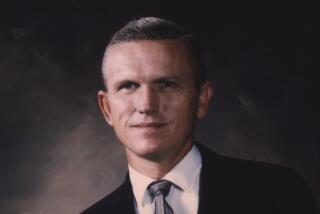Engineer helped advance space travel
- Share via
Peter Staudhammer, a former USC executive who helped design the engine that landed astronauts on the surface of the moon, died Monday at his home in La Quinta from complications of cancer. He was 73.
He served as vice president and chief technical officer for former military giant TRW before becoming chief operating officer of the Alfred E. Mann Institute for Biomedical Engineering at USC.
“Pete Staudhammer was an engineer’s engineer -- a broadly competent engineer, both highly analytical and innovative,” said Simon Ramo, co-founder of TRW.
“Everyone -- young engineers and senior experts -- would come to consult him. . . . He will be greatly missed,” Ramo said.
Born in Hungary, Staudhammer earned his undergraduate degrees and a doctorate in chemical engineering at UCLA.
In 42 years at TRW Inc., which was acquired by North- rop Grumman Corp. in 2002, Staudhammer performed research and led development work on rocket engine combustion, space-borne instrumentation and high-energy lasers.
He pioneered hydrazine-fueled rocket engines and developed science instruments for the exploration of Venus, Mars, Jupiter and Saturn. One of the most famous was the Viking Biology Experiment, a miniature working laboratory that was the first instrument to search for life on Mars.
Smaller than a gallon container, the lab consisted of ovens, lamps and biomedical analyzers. It contained 40,000 parts.
“It worked better on Mars than on Earth,” Staudhammer said in a 1996 interview. “And remember, it used technology from the early 1970s.”
Though the experiment found no signs of microbial life, the research became the foundation for the more detailed current search of the Red Planet for evidence of ancient biological processes.
He also was the chief engineer for the Apollo program’s lunar descent engine, which allowed astronauts to make soft landings on the surface of the moon.
Staudhammer retired from TRW in 2002 as chief technical officer and vice president for science and technology, overseeing the work of 17,000 engineers and scientists worldwide.
Like many veterans from the early days of the space program, Staudhammer was critical of the bureaucratic, risk-averse culture he believed had overtaken NASA. “Today, we are far too slow in the space business,” he said in the 1996 interview.
From 2003 until declining health forced him to resign last year, Staudhammer directed USC’s Mann Institute. He also worked as a research professor in USC’s Department of Biomedical Engineering.
The recipient of numerous awards, he was given NASA’s Distinguished Public Service Medal in 2002. UCLA’s School of Engineering named him Alumnus of the Year in 1992, and UC Riverside named him Industrialist of the Year in 2004.
He is survived by his wife, Marie; six children; and six grandchildren.
--





